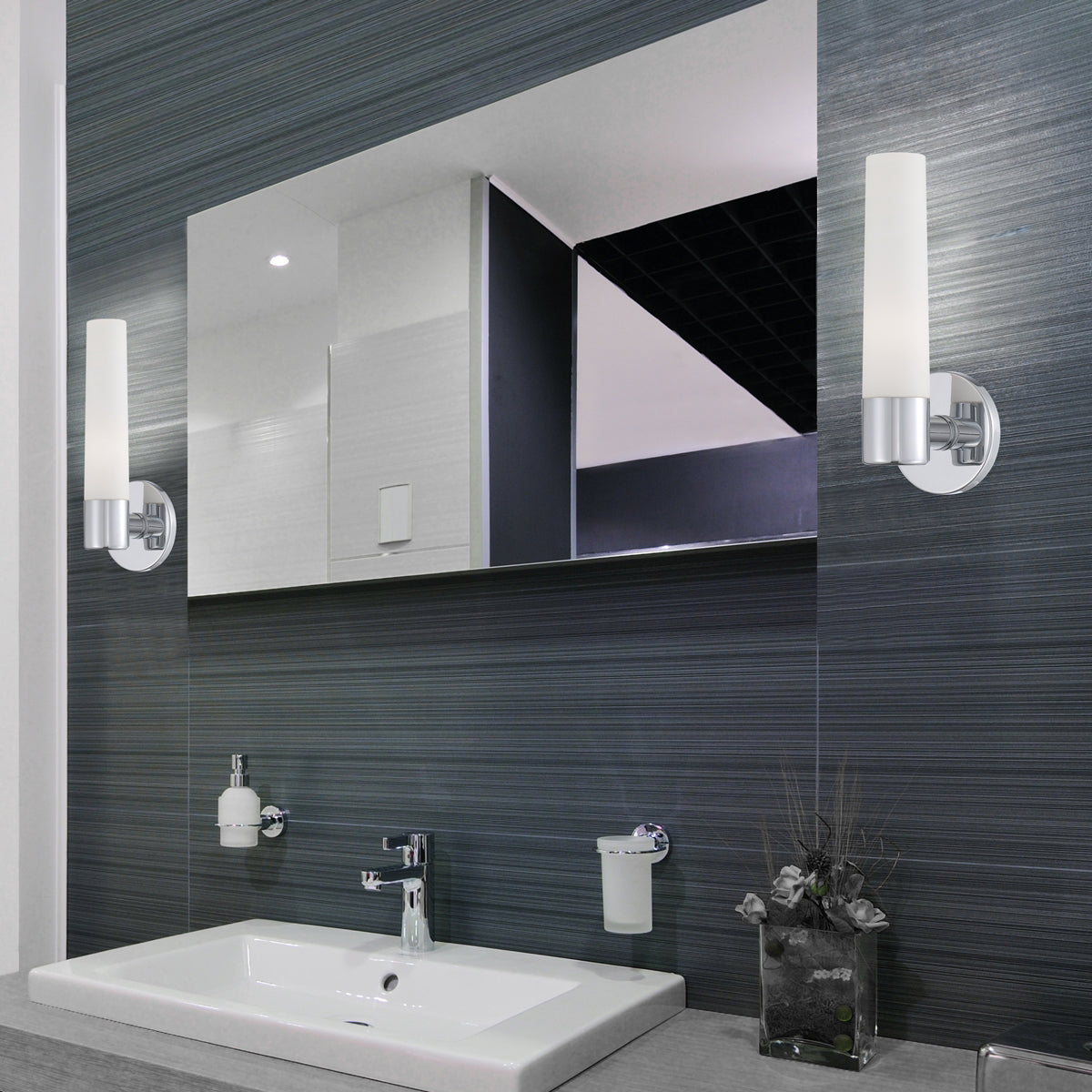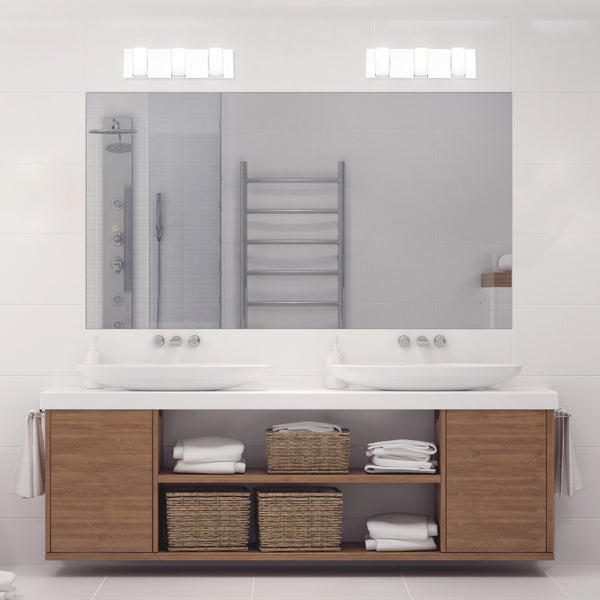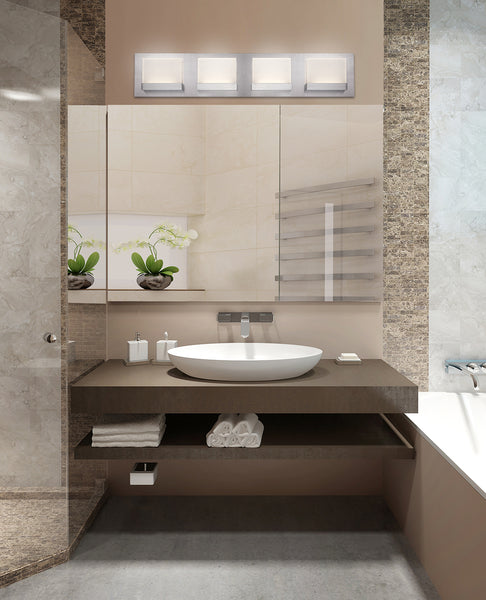On orders $99+
On orders $99+

The answer really hinges on a couple of key factors, like the size of your vanity and the level of illumination you need for your daily routines. Generally speaking, if you have a single vanity, a pair of sconces placed on either side of the mirror can offer beautiful, balanced lighting that's perfect for detailed tasks. This setup eliminates those pesky shadows that overhead lighting alone can cast on your face. For double vanities, you might consider a similar approach for each sink, ensuring each area is well-lit. Another option is a series of evenly spaced pendant lights or a linear light fixture above the mirror, which can also provide ample lighting across the entire vanity. Think of it as setting the stage for all your grooming activities!
Lighting up a bathroom vanity is akin to setting the stage for a daily performance, where precision in tasks meets the allure of aesthetics. This illuminative journey often presents a myriad of decisions for DIY homeowners and aspiring interior designers, turning the quest for the perfect number of lights into a blend of art and science. Let’s embark on an exploration to demystify how to bathe your bathroom vanity in the ideal glow, weaving through the practical needs and design dreams that make a bathroom not just seen but experienced.

At the heart of every bathroom, the vanity stands as a beacon of functionality—where the day begins with rituals of grooming and beauty. Yet, without the right lighting, this sanctuary can quickly become a stage for the all-too-familiar dance of straining to see and battling with shadows. The quest, then, is not just about choosing lights but about orchestrating illumination that turns every reflection into clarity.
Choosing the optimal number of lights for a bathroom vanity transcends mere aesthetics—it's a blend of functionality, design harmony, and the nuanced requirements of daily grooming rituals. This decision is guided by a careful consideration of the vanity's dimensions, the ambient lighting conditions of the bathroom, and the nature of tasks undertaken at the vanity.
For Single Vanities: The lighting choice hinges on creating a balanced interplay of light and shadow, essential for precision tasks like applying makeup or shaving. A symmetrical arrangement of two sconces, flanking the mirror on either side, emerges as a popular and effective solution. This setup bathes the face in even, flattering light from multiple directions, mitigating the formation of unflattering shadows.
An alternative strategy involves opting for a broader, singular light fixture positioned above the mirror. This choice is apt when it spans at least two-thirds the mirror's width, casting a wide arc of light that encompasses the vanity. However, this configuration often necessitates the addition of strategic recessed lighting overhead to disperse light evenly and soften any residual shadows, ensuring a uniformly lit workspace.
For Double Vanities: Navigating the lighting scheme for double vanities introduces a layer of complexity, demanding a tailored approach to adequately illuminate each individual section. The essence of this setup is to replicate the balanced lighting of single vanities for each sink area, ensuring that both sides benefit from optimal visibility without interference from shadows. This might manifest as a pair of sconces stationed on either side of both mirrors, creating a mirroring effect that enhances symmetry and functional lighting.
Alternatively, a continuous linear light fixture stretched across the length of each mirror can offer a sleek, unified look while providing ample illumination across the vanity's expanse. The critical objective here is to foster an environment where light is distributed evenly, ensuring that every inch of the vanity is accessible and well-lit, facilitating a range of grooming activities without compromise.

Crafting the perfect lighting scenario for a bathroom vanity is an intricate dance between eliminating unwanted shadows and ensuring the light complements, rather than detracts from, the room's beauty. Achieving this delicate balance requires a keen attention to detail and an understanding of how light interacts with space:
Shadows are the perennial adversaries of effective vanity lighting, capable of transforming routine grooming into a challenge. The strategic placement of side sconces at eye level, typically between 65 to 70 inches from the floor, emerges as a crucial tactic in this battle. Positioned on either side of the mirror, these sconces cast a light that envelops the face from all angles, mitigating the creation of shadows and providing a uniform brightness that enhances visibility. This setup not only facilitates precision in personal grooming tasks but also contributes to a more flattering reflection, free from the distortion of harsh shadows.
In larger bathrooms, or those with limited natural light, achieving an evenly lit space can be challenging. Here, the art of layering lighting becomes indispensable. By integrating ambient overhead lighting with purposeful accent lights, you can create a layered effect that illuminates the vanity area comprehensively. Ambient lighting establishes the baseline level of illumination, while accent lighting—such as under-cabinet lights or recessed spotlights—highlights specific areas, ensuring that every nook and cranny of the vanity is visible and well-lit. This approach not only ensures functional lighting for grooming tasks but also adds depth and dimension to the space, making the bathroom feel more open and inviting.
The ultimate goal in selecting vanity lighting is to find fixtures that resonate with both the aesthetic sensibilities of the bathroom and the practical necessities of daily use. This involves choosing lights that not only complement the room’s design theme but also offer the flexibility to adapt to varying needs. LED fixtures with dimming capabilities stand out as versatile options, enabling users to adjust the lighting intensity to suit different times of day and activities, from the bright, focused light needed for morning preparations to the softer, more subdued glow preferred for relaxing baths in the evening. By prioritizing fixtures that offer both style and adjustable functionality, you can create a vanity area that is not only practical but also an expression of your personal design ethos.

The journey to determining the ideal number of lights for a bathroom vanity is a meticulous one, requiring a deep understanding of spatial dynamics, personal grooming needs, and aesthetic preferences. Whether navigating the simplicity of a single vanity or the intricate requirements of a double setup, the ultimate aim remains the same: to craft a space that is both beautifully lit and supremely functional. By embracing these principles, DIY homeowners and aspiring interior designers can transform a bathroom vanity into a beacon of light, where every day begins with clarity, precision, and a touch of style.
Helpful Links:
Discover Our Designer Selection of Bathroom Vanity Lighting Fixtures!
Bathing in Brilliance: The Perfect Bathroom Ceiling Lighting Guide
Leave a comment